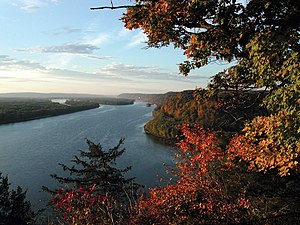Mississippi Valley
| Mississippi River | |
| Ojibwe: Misi-ziibi, Dakota: Mníšošethąka, Myaamia: Mihsi-siipiiwi, Cheyenne: Ma'xeé'ometāā'e, Kiowa: Xósáu, Arapaho: Beesniicie, Pawnee: Kickaátit | |
|
Mississippi River near Fire Point in Effigy Mounds National Monument, Iowa
|
|
| Name origin: Ojibwe word misi-ziibi, meaning "Great River", or gichi-ziibi, meaning "Big River" | |
| Nickname: "Old Man River" | |
| Country | United States |
|---|---|
| States | Minnesota, Wisconsin, Iowa, Illinois, Missouri, Kentucky, Tennessee, Arkansas, Mississippi, Louisiana |
| Tributaries | |
| - left | St. Croix River, Wisconsin River, Rock River, Illinois River, Kaskaskia River, Ohio River |
| - right | Minnesota River, Des Moines River, Missouri River, White River, Arkansas River, Red River |
| Cities | Minneapolis, MN, St. Paul, MN, La Crosse, WI, Quad Cities, IA/IL, St. Louis, MO, Memphis, TN, Baton Rouge, LA, New Orleans, LA |
| Source | Lake Itasca |
| - location | Itasca State Park, Clearwater County, MN |
| - elevation | 1,475 ft (450 m) |
| - coordinates | 47°14′23″N 95°12′27″W / 47.23972°N 95.20750°W |
| Mouth | Gulf of Mexico |
| - location | Pilottown, Plaquemines Parish, LA |
| - elevation | 0 ft (0 m) |
| - coordinates | 29°09′04″N 89°15′12″W / 29.15111°N 89.25333°WCoordinates: 29°09′04″N 89°15′12″W / 29.15111°N 89.25333°W |
| Length | 2,320 mi (3,734 km) |
| Basin | 1,151,000 sq mi (2,981,076 km2) |
| Discharge | for mouth; max and min at Baton Rouge, LA |
| - average | 593,000 cu ft/s (16,792 m3/s) |
| - max | 3,065,000 cu ft/s (86,791 m3/s) |
| - min | 159,000 cu ft/s (4,502 m3/s) |
The Mississippi River is the chief river of the largest drainage system on the North American continent. Flowing entirely in the United States (although its drainage basin reaches into Canada), it rises in northern Minnesota and meanders slowly southwards for 2,320 miles (3,730 km) to the Mississippi River Delta at the Gulf of Mexico. With its many tributaries, the Mississippi's watershed drains all or parts of 31 U.S. states and 2 Canadian provinces between the Rocky and Appalachian Mountains. The Mississippi ranks as the fourth longest and fifteenth largest river in the world by discharge. The river either borders or passes through the states of Minnesota, Wisconsin, Iowa, Illinois, Missouri, Kentucky, Tennessee, Arkansas, Mississippi, and Louisiana.
Native Americans long lived along the Mississippi River and its tributaries. Most were hunter-gatherers, but some, such as the Mound Builders, formed prolific agricultural societies. The arrival of Europeans in the 16th century changed the native way of life as first explorers, then settlers, ventured into the basin in increasing numbers. The river served first as a barrier, forming borders for New Spain, New France, and the early United States, and then as a vital transportation artery and communications link. In the 19th century, during the height of the ideology of manifest destiny, the Mississippi and several western tributaries, most notably the Missouri, formed pathways for the western expansion of the United States.
...
Wikipedia


